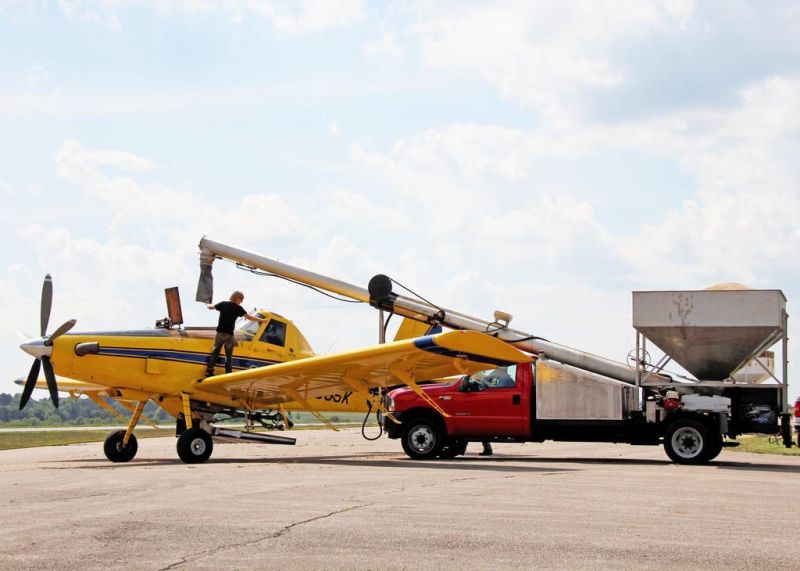Cover crop Fly On Day begins Sept. 7
- Michelle Wood
- September 2, 2021
- 1177
Tuesday, Sept. 7 is when months of work will culminate in the satisfaction of Fly On Day, as we call it, when cover crops will be aerially seeded over Holmes County. Yellow and blue Air Tractors manned by Fisher Ag Services pilots will swoop and climb over crop fields, dropping barley, oats and rye seeds for cover crops.
Fly On Day is even more noteworthy than usual as we look forward to meeting with the Ohio Department of Agriculture director Dorothy Pelanda and Muskingum Watershed Conservancy District executive director Craig Butler at the Holmes County Airport to observe the aerial seeding and discuss the benefits of the program. The Holmes SWCD program has been a pilot for other counties, and we are thrilled to have conservation impacts beyond the Holmes County border.
Holmes SWCD began a coordinated aerial cover crop initiative way back in 2009. Sowing cover crops by plane isn’t a new concept, but it’s a lot easier for farmers to participate in a coordinated effort than to make the arrangements themselves.
Several years ago the Muskingum Watershed Conservancy District recognized promoting cover crops met its water-quality initiatives and launched a per-acre cost-share program in cooperation with the Ohio Department of Agriculture Division of Soil and Water Resources to the 18 counties within the Muskingum River Watershed. That initiative annually results in about 255 landowners over the region being approved for over 27,000 acres of cover crops, totaling approximately $385,000 of incentive each year.
So what’s the big deal about cover crops? Cover crops are planted to provide growing plants over the winter months. Even if the cold kills the plants, the roots and plant residue provide protection for the soil. Bare soil is vulnerable to each tiny raindrop that falls. Topsoil is precious. It’s the layer that provides nutrients to grow crops, so farmers have a vested interest in keeping it in place.
Plus, sediment, which is misplaced soil in a stream or water body, chokes out aquatic life and creates maintenance issues for ditches, ponds and water sources. Farmers who sow cover crops are not only benefiting their farms, but also the water resources of the entire watershed.
Aerial application is just one method for farmers to sow cover crops, and its appeal is it takes the management out of sowing cover crops. The farmers let us know which fields they want flown and what seed they want, the plane flies over, and it’s done, saving them the task of sowing another crop. This method works the best on standing (still growing in the field) soybeans. Once the soybeans are harvested, the seeds get enough light to grow before the bitter winter months.
The downside of aerial application is the stand is not as thick as if a farmer drills or broadcasts seed. If the farmer wants the crop for forage — feed for animals — then drilling or broadcasting is preferred. But he must count on good weather and enough growing season after the harvest for drilling, plus labor/equipment/fuel expenses to make another pass across the fields.
Kudos to Holmes SWCD staff members Karen Gotter, Joe Christner and Donna Wiseman for taking applications, mapping fields and crunching numbers to make the program so successful. Holmes County farmers were approved for cost-share on 6,205 acres this year through this initiative. Approximately 2,700 acres will be seeded aerially, and another 5,000 acres or so were applied for to be drilled later this fall. Not all drilled acres will receive cost-share, but many farmers plant them anyway at their own expense.
We are pleased to be able to offer almost $79,500 in cost-share to Holmes County farmers for this important conservation practice through the MWCD/ODA program.
Our district appreciates the support we receive from Sweet Breeze Farms and Excavating, Goodwill Farms, and TSN Farms as they assist with trucking seed to the airport and equipment to load the planes, plus the cooperation of the staff at the Holmes County Airport.
If you have questions about our cover crop program, call our office at 330-674-SWCD. And as always, the planes are dropping seed only; no pesticides or herbicides are being used. If you get some nice photos of the planes in action, tag our Facebook page at Holmes Soil & Water Conservation District.

